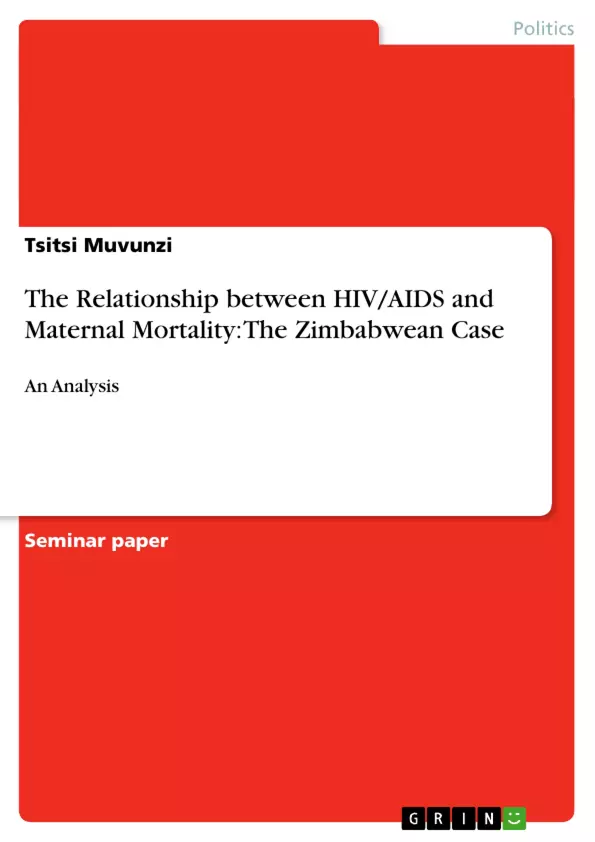One of the major fundamental principles of modern development theories is the acknowledgement that HIV/AIDS is at the root of high levels of maternal mortality in third world countries and that a decrease in HIV/AIDS should correspond directly with a decline in maternal mortality statistics. This is premised on the assumption that, it is a reflection of positive development, where development as a field of analysis is concerned. Whereas this principle fits in most of the development situations across the third world, it does not seem to apply in the case of Zimbabwe. Health statistics in Zimbabwe reflect that while HIV/AIDS prevalence rate among the adult population has declined over the years (from 26.5% in 2002 to 13.7% in 2009), maternal mortality ratio has increased (from 283 per 100 000 live births in 1994 to 1300 per 100 000 live births in 2009) as revealed by the Central Statistical Report (2010) and the Zimbabwe 2004 MDG Report.
Inhaltsverzeichnis (Table of Contents)
- PART 1: INTRODUCTION
- PROBLEM STATEMENT
- RESEARCH OBJECTIVES
- THESIS
- RESEARCH QUESTIONS
- METHODOLOGY
- PART 2: OVERVIEW OF MATERNAL MORTALITY AND HIV/AIDS PREVALENCE IN ZIMBABWE
- MATERNAL MORTALITY IN ZIMBABWE
- Patterns of Maternal Mortality in Zimbabwe
- Government's Initiatives to Curtail Maternal Mortality
- ZIMBABWE'S HIV/AIDS RATE
- Patterns of HIV/AIDS Prevalence Rate Among Pregnant Women
- Government's Initiatives to Combat HIV/AIDS
- ANALYSIS OF HIV/AIDS AS A CAUSE FOR MATERNAL DEATHS
- PART 3: CAUSES OF MATERNAL MORTALITY OTHER THAN HIV/AIDS
- SOCIAL, RELIGIOUS AND CULTURAL FACTORS
- Religious Factors
- Social and Cultural Factors
- Abortion
- ECONOMIC FACTORS
- Transport
- Unwanted Pregnancies
- Shortage of Health Workers
- Nutritional Factors
- HEALTH RELATED FACTORS
- Sub-Optimal Management of Hospitals
- Hemorrhage
- PART 4: CONCLUSIONS AND RECOMMENDATIONS
Zielsetzung und Themenschwerpunkte (Objectives and Key Themes)
This research paper aims to investigate the relationship between HIV/AIDS prevalence and maternal mortality rates in Zimbabwe, particularly focusing on the female fertile age group. It aims to analyze the trends in HIV/AIDS and maternal mortality, explore other factors contributing to maternal mortality, and provide recommendations for addressing the alarming increase in maternal mortality rates.
- The relationship between HIV/AIDS prevalence and maternal mortality rates in Zimbabwe
- The impact of social, economic, political, and cultural factors on maternal mortality
- The role of government initiatives in combating HIV/AIDS and reducing maternal mortality
- The importance of addressing other factors beyond HIV/AIDS to reduce maternal deaths
- Policy recommendations for addressing the alarming rise in maternal mortality in Zimbabwe
Zusammenfassung der Kapitel (Chapter Summaries)
The first chapter introduces the research topic, highlighting the discrepancy between declining HIV/AIDS prevalence and increasing maternal mortality in Zimbabwe. It outlines the research objectives, thesis statement, and research questions, as well as the methodology employed. The second chapter provides an overview of maternal mortality and HIV/AIDS prevalence in Zimbabwe, presenting data on trends, government initiatives, and the analysis of HIV/AIDS as a cause for maternal deaths. Chapter three delves into causes of maternal mortality beyond HIV/AIDS, examining social, religious, cultural, economic, and health-related factors contributing to the problem.
Schlüsselwörter (Keywords)
Maternal mortality, HIV/AIDS, Zimbabwe, social determinants, economic factors, health systems, policy recommendations, Millennium Development Goals.
- Quote paper
- Tsitsi Muvunzi (Author), 2011, The Relationship between HIV/AIDS and Maternal Mortality: The Zimbabwean Case, Munich, GRIN Verlag, https://www.grin.com/document/214170



